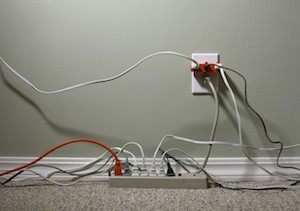 Below Are Some Tips to Promote Safety in Your Home, but Not Limited to:
Below Are Some Tips to Promote Safety in Your Home, but Not Limited to:
- Keep items such as hairdryers or appliances with cords out of the bathroom. These non-essential objects should never be used near bathtubs or sinks that are filled with water. Teaching your children that electricity and water do not mix is essential for everyone’s safety.
- Routinely check your household cords for wear and torn. A worn cord can result in shock, short circuit or even fire. Teach your children NEVER to put an object into an electrical outlet and always keep cords away from your children.
- Properly place electrical cords in locations that are safe. DO NOT place electrical cords under rugs or furniture as this can make the cord(s) fray or overheat.
- DO NOT overload electrical outlets as this can cause circuit breakers to blow frequently. Making sure the size of the cord fits the appliance or equipment is vital for your safety. If you notice your television screen flicker or change size, you may wish to have a N.C. certified electrician inspect your wiring and circuits.
- Never pull a cord out of the electrical socket by yanking the cord itself. Instead you should always pull the rubber housing to remove it from the socket. Also, never pull an appliance by the cord.
- Limit your use of extension cords as this could lead to circuit overload.
When it comes to the safety of yourself and others, you can never take too many precautions. Take necessary action today to protect yourself and maintain a life that is safe and sound.

 Tom's Blog
Tom's Blog



